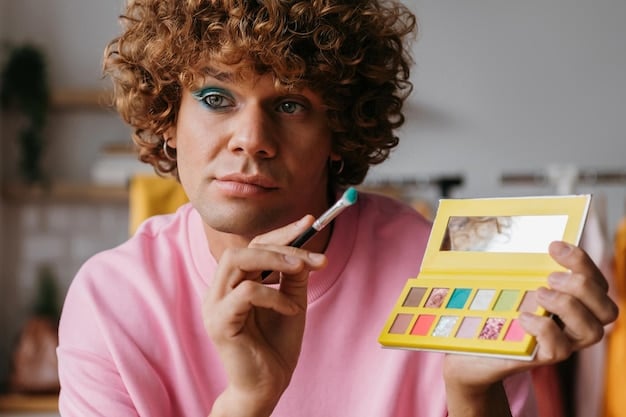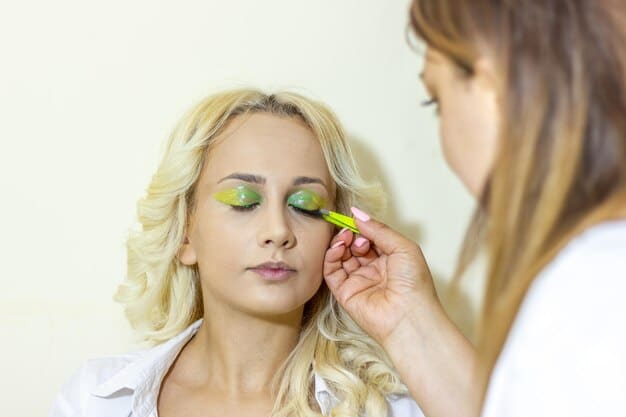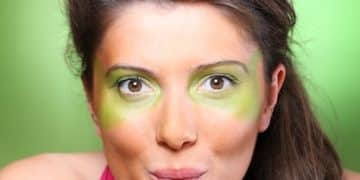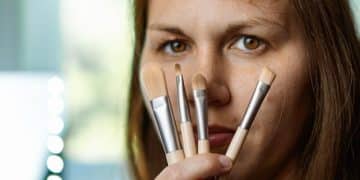Color Correcting Guide: Banish Blemishes and Imperfections

The Ultimate Guide to Color Correcting: Banish Blemishes and Imperfections is your comprehensive resource for neutralizing skin discolorations using the principles of color theory, helping you achieve a flawless and even-toned complexion by understanding and applying complementary colors.
Unlock the secret to a flawless complexion with The Ultimate Guide to Color Correcting: Banish Blemishes and Imperfections. Say goodbye to unwanted redness, dark circles, and discoloration as we delve into the art of neutralizing imperfections using color theory.
Understanding Color Correcting
Color correcting might seem like a daunting task, but breaking it down into manageable steps makes it easy to master. It’s all about using complementary colors to neutralize unwanted tones on your skin.
Essentially, color correcting is a makeup technique used to neutralize unwanted discoloration on the skin before applying foundation or concealer. By understanding the color wheel and which colors cancel each other out, you can effectively address issues like redness, dark circles, and sallowness.
The Color Wheel
The color wheel is your best friend when it comes to color correcting. It visually represents the relationships between colors, showing which ones are complementary (opposite each other) and thus, can neutralize each other.
Complementary Colors
Understanding complementary colors is crucial. Here’s a quick rundown:
- Green: Neutralizes Redness
- Peach/Orange: Corrects Blue/Purple Undertones
- Yellow: Brightens Dullness and Corrects Purple
- Purple/Lavender: Counteracts Yellow Undertones
These colors, when applied strategically, can help create an even canvas for your foundation and concealer, leading to a more natural and flawless finish.
In summary, mastering the color wheel and understanding complementary colors is the foundation of effective color correcting. It’s about using the right hues to cancel out unwanted discoloration and create a balanced complexion.

Identifying Your Skin Concerns
Before diving into color correctors, it’s essential to identify your specific skin concerns. This will guide you in choosing the right colors to use.
Knowing exactly what you want to correct ensures you’re using the right products and techniques. Here are some common skin concerns and how to identify them:
Redness
Redness can be caused by acne, rosacea, sunburn, or general irritation. It often appears around the nose, cheeks, and chin. If you notice blotchy red patches on your skin, especially after cleansing or applying certain products, you likely need a green color corrector.
Dark Circles
Dark circles can range in color from blue to purple to brown. Blue or purple dark circles are common in fair skin tones and indicate thin skin that shows the underlying blood vessels. Brown dark circles are often a result of hyperpigmentation. Peach or orange correctors work well for blue and purple circles, while a yellow corrector can help brighten brown circles.
Dullness and Sallowness
Dullness can make your skin look tired and lifeless. Sallowness, or a yellowish tint, can be caused by illness, smoking, or aging. A lavender or purple corrector can brighten dull skin and counteract yellow undertones, giving your face a more vibrant and healthy appearance.
By carefully assessing your skin and identifying the specific issues you want to address—whether it’s redness, dark circles, or dullness—you can make informed decisions about which color correctors to use.
Choosing the Right Color Correctors
Once you know what you need to correct, selecting the right color corrector is the next crucial step. Different formulas and shades cater to various skin types and tones.
From creams to liquids to powders, the options can be overwhelming. Here’s a guide to help you choose:
- Green Correctors: Ideal for neutralizing redness from acne, rosacea, or sunburn. Look for a green corrector that matches the intensity of your redness. For mild redness, a light green shade will suffice. For more intense redness, opt for a deeper green.
- Peach/Orange Correctors: Perfect for correcting blue or purple undertones, commonly found under the eyes. Light peach shades are great for fair skin, while deep orange shades work better for dark skin.
- Yellow Correctors: Excellent for brightening dullness and correcting purple or brown discoloration. Yellow correctors are versatile and can be used on a variety of skin tones to add radiance.
- Purple/Lavender Correctors: Best for counteracting yellow undertones and brightening dull skin. Lavender correctors are particularly effective for those with sallow complexions or mature skin.
Selecting the right color corrector involves matching the shade to your skin tone and the specific discoloration you want to neutralize. It’s also important to consider the formula that works best for your skin type, whether that’s cream, liquid, or powder.
Application Techniques
Applying color correctors correctly is key to achieving a natural look. Too much product can lead to a muddy appearance, while too little won’t provide enough coverage.
Here are some essential techniques to keep in mind:
Prep Your Skin
Start with a clean, moisturized face. Applying a primer can also help create a smooth canvas for your color correctors and ensure they last longer.
Apply Sparingly
Use a small amount of product and build up the coverage as needed. Over-application can make your makeup look cakey and unnatural. Use a makeup sponge, brush, or your fingertips to gently pat the color corrector onto the affected areas.
Blend Well
Blend the color corrector seamlessly into your skin. Use light, tapping motions to avoid disturbing the product underneath. Pay special attention to the edges to ensure there are no harsh lines.
Follow with Foundation and Concealer
After color correcting, apply your regular foundation and concealer. Choose products that provide adequate coverage without being too heavy. Apply these products with a light hand to avoid shifting the color corrector.

Proper application techniques are crucial for achieving a natural, flawless finish with color correcting. Remember to prep your skin, apply the product sparingly, blend well, and follow with your foundation and concealer for a seamless look.
Common Mistakes to Avoid
Color correcting can be tricky, and making mistakes is part of the learning process. Knowing common pitfalls can help you avoid them and achieve better results.
Here are some frequent errors to watch out for:
- Using Too Much Product: Over-application is one of the most common mistakes. Start with a small amount of product and build up the coverage as needed.
- Not Blending Properly: Poor blending can result in harsh lines and an unnatural appearance. Take the time to blend the color corrector seamlessly into your skin.
- Choosing the Wrong Shade: Selecting the wrong color corrector can exacerbate the problem. Ensure you’re choosing the right shade to neutralize the specific discoloration on your skin.
Ignoring Your Skin Type
Different skin types require different formulas. If you have oily skin, opt for lightweight, oil-free formulas. If you have dry skin, choose hydrating, creamy products.
Avoiding these common mistakes—such as over-applying product, not blending properly, choosing the wrong shade, and ignoring your skin type—can significantly improve your color correcting results. With practice and attention to detail, you can achieve a flawless and natural-looking complexion.
Advanced Color Correcting Techniques
Once you’ve mastered the basics, you can explore advanced techniques to enhance your color correcting skills. These methods add dimension and refinement to your makeup routine.
Consider incorporating these advanced techniques into your routine:
Layering Correctors
For complex issues like severe dark circles, consider layering different correctors. Start with a peach or orange corrector to neutralize the blue or purple undertones, then follow with a yellow corrector to brighten the area.
Using Multiple Correctors
You can use multiple correctors on different areas of your face simultaneously. For example, use a green corrector on red areas around your nose and cheeks, while using a peach corrector under your eyes.
Highlighting and Contouring
Incorporate highlighting and contouring to further enhance your complexion. Use a concealer that’s one to two shades lighter than your skin tone to highlight the high points of your face, and a contour shade to add dimension and definition.
As you become more comfortable with color correcting, experimenting with different techniques can lead to even better results. Layering correctors, using multiple correctors, and incorporating highlighting and contouring can help you achieve a truly flawless complexion.
| Key Point | Brief Description |
|---|---|
| 🟢 Neutralize Redness | Use green corrector for acne, rosacea, or sunburn. Apply sparingly and blend well. |
| 🍑 Correct Dark Circles | Peach or orange correctors for blue/purple; yellow for brown circles. |
| ✨ Brighten Dullness | Lavender or purple correctors combat yellow undertones. |
| 🎨 Blend Carefully | Ensure seamless blending for a natural, flawless finish. Avoid harsh lines. |
FAQ
▼
Color correcting is a makeup technique that uses complementary colors to neutralize unwanted discoloration on the skin, creating an even base before applying foundation.
▼
Identify your skin concern first. Green neutralizes redness, peach/orange corrects blue/purple undertones, yellow brightens dullness, and purple counteracts yellow undertones.
▼
Yes, peach or orange correctors are commonly used to neutralize blue or purple dark circles. Apply a small amount and blend well before applying concealer.
▼
Use light, tapping motions with a makeup sponge, brush, or your fingertips to gently blend the color corrector into your skin. Ensure there are no harsh lines.
▼
While you can, it’s generally recommended to follow with foundation and concealer to even out your skin tone and provide a flawless finish after color correcting.
Conclusion
Mastering color correcting is a powerful skill that can transform your makeup routine. By understanding the color wheel, identifying your skin concerns, and practicing the right application techniques, you can achieve a flawless, even-toned complexion. With patience and persistence, you’ll soon be able to banish blemishes and imperfections with ease.





